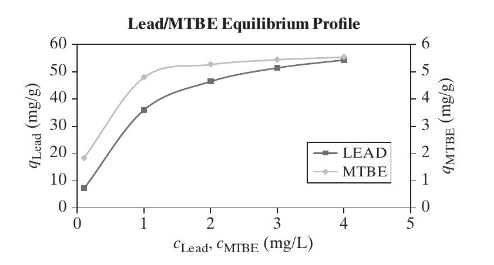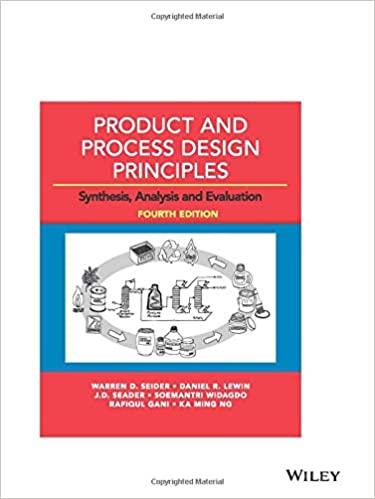A household goods company decides to produce a faucet mount water filter for removing organic and metallic
Question:
A household goods company decides to produce a faucet mount water filter for removing organic and metallic contaminants from tap water. The filter is made up of activated carbon and ionexchange resin. As a measure of product performance, tap water with \(346 \mu \mathrm{g} / \mathrm{L}\) of methyl-t-butyl ether (MTBE) and \(370 \mu \mathrm{g} / \mathrm{L}\) of lead ions at a flow rate of \(7.5 \mathrm{~L} / \mathrm{m}\) at \(25^{\circ} \mathrm{C}\) is used as a reference inlet stream. The filter must last at least two months for a four-member family. The daily drinking water consumption per person is \(2 \mathrm{~L}\).
(a) The equilibrium data of MTBE adsorption on activated carbon and lead on ion-exchange resin at \(25^{\circ} \mathrm{C}\) have been obtained below. Determine from the equilibrium data the parameters for the Langmuir isotherm,
\[q=\frac{q_{\max } K_{A} c}{1+K_{A} c}\]
Here, \(q\) is the amount of solute adsorbed ( \(\mathrm{mg} / \mathrm{g}\) of adsorbent), \(q_{\max }\) is the maximum amount of solute adsorbed \((\mathrm{mg} / \mathrm{g}), K_{A}\) is the adsorption equilibrium constant \((\mathrm{L} / \mathrm{mg})\), and \(c\) is the amount of solute in bulk liquid (mg/L).

(b) Using the Langmuir parameters calculated in part (a), determine the product specifications of the faucet water filter. Specifically, what should be the dimensions of the filter? What is the ratio of activated carbon to ion-exchange resins in the filter?
To simplify the problem, local equilibrium can be assumed to take place throughout the filter. Axial dispersion and diffusion effects are negligible. MTBE is adsorbed by activated carbon and lead by activated ion-exchange resins, separately. With these assumptions, the velocity of each solute, \(u\), is given by (Wankat, 1990),
\[u=\frac{v_{i}}{1+\frac{1-\varepsilon}{\varepsilon} ho_{p}\left(\frac{q_{2}-q_{1}}{c_{2}-c_{1}}\right)}\]
Here, \(\varepsilon\) is the void fraction of the filter, \(v_{i}\) is the interstitial velocity of fluid flow [= volumetric flow rate/(filter cross-sectional area \(\times\) void fraction)], \(ho_{p}\) is particle density, and 1 and 2 refer to before and after feeding the tap water to the filter, respectively. The density of the activated carbon and ion-exchange resins are \(800 \mathrm{~g} / \mathrm{L}\) and \(1,190 \mathrm{~g} / \mathrm{L}\), respectively. The void fraction is 0.4.
(c) Discuss how to solve this design problem if local equilibrium is not valid.
Step by Step Answer:

Product And Process Design Principles Synthesis Analysis And Evaluation
ISBN: 9781119355243
4th Edition
Authors: Warren D. Seider, Daniel R. Lewin, J. D. Seader, Soemantri Widagdo, Rafiqul Gani, Ka Ming Ng





